|
|
|

Very handsome plant with large tubercles or warts on upper
leaf surface and soft white teeth along the edges;
|
|
Description: Faucaria
tuberculosa is a low growing clump-forming, perennial succulent,
it is one of the easiest species to identify, since it is the only one
with white tubercles on the top of the leaves.
Leaves: In opposite pairs, all pairs growing at right angles to
the next adjacent, usually with 2 to 4 pairs to a branch, they are up
to 2,5 cm long, by 2 cm wide, dark green thick ovate-triangular in the
top view, scattered in white rough tubercles over the upper surface and
edged with soft white structures that look like teeth.
Flowers: Large, daisy-like, yellow (sometime red tipped), 4 cm in
diameter and may have up to 200 petals. They need full sun to open fully
and often don't open at all if the weather is cloudy, or if they are in
the shade.
Blooming time: Flowers will usually come out in the autumn
(October or November) and bloom for several months (also in winter and
spring if the growing conditions are adequate). The flowers open around
midday and close in the late afternoon.
Fruit: The fruit is a short, bell-shaped, compartmented (loculicidal),
valve-closed capsule, about 10mm in diameter, which opens and closes
with changes in the moisture content of the air (hygrochastic) to allow
release of the numerous seeds. Note, however, that compartmentation
allows a few seeds to remain each time seeds are allowed to escape. This
arrangement is a very beneficial one, in a harsh habitat, for it allows
something like periodical release of seed during wet times and
protection of reserves during dry seasons. As well, reserves are kept
available to replace earlier releases which may not survive their
vulnerable, early germination period.
|
|
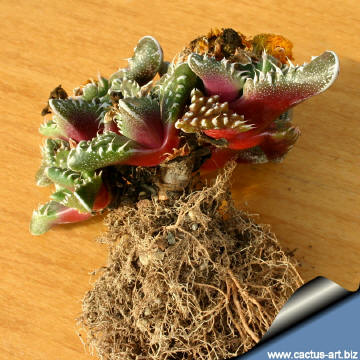 |
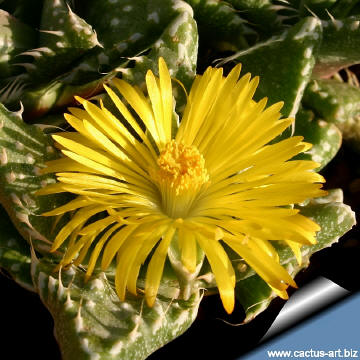 |
|
. |
|
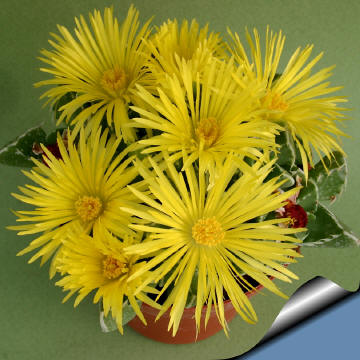 |
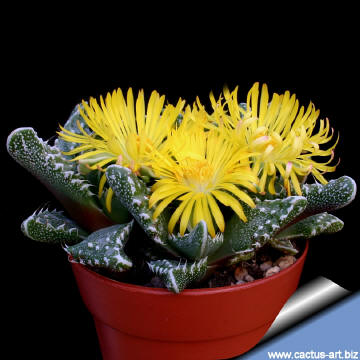 |
|
Culture: Faucarias are la good choice for anyone wanting to start
growing succulents. They are quite hardy and can take a short period of
light frost and in very dry warm regions these succulents make very
impressive out door ground covers. They need full sun to light
shade with a well-drained soil mix, but can tolerate a wide variety of
soil types and growing locations as long as there is plenty of sun. The
plants are well watered during the growing season and allowed to dry
thoroughly before watering again and will tolerate some over watering,
but the challenge is to help them keep their compact form and prevent
elongation of the stem. During the winter months, the plants should be
kept very dry, only watering enough to keep the leaves from shrivelling.
As house plants they tend to grow in fair weather and rest when
temperatures are too hot or too cool.
|
|


Advertising
|
|
|
|
|
Family: Mesebrianthemaceae (Aizoaceae)
Scientific name:
Faucaria felina ssp. tuberculosa (Rolfe)
Groen & V.D.Haesen 1999
Origin: South Africa (Cape Province: Bedford)
Common Names include: Pebbled Tiger Jaws, Tiger Jaws’,
Knobby Tiger Jaws, Shark's Jaws,
Synonyms:
- Mesembryanthemum tuberculosum
Rolfe 1916
- Faucaria tubercolosa Schwantes
1926
- Faucaria felina (L.) Schwantes
Note: Faucaria felina
is a very variable taxon that now comprises many Faucaria’s form
previously considered independent the species, and the very large
majority of Faucaria sp. sold in numerous nursery must be
considered just
Faucaria tigrina. The plant in cultivation and
labeled Faucaria tuberculosa are frequently hybrids. This is not
surprising in view of its close similarity to F. felina with
which it shares the habitat and with which naturally interbreed (in
natural habitats too!). Cultivated plants shows a wide morphologic
variability especially regarding the density of the white tubercles on
the upper surface of the leaves. Some plant have an almost smooth leaf
surface (and are not distinguishable from Faucaria felina)
while on the other hands some other are very densely covered by rough
and irregular tubercles.
|
|
|
|
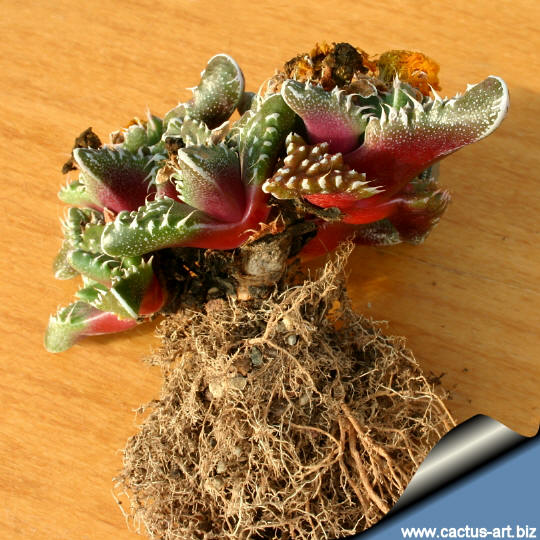
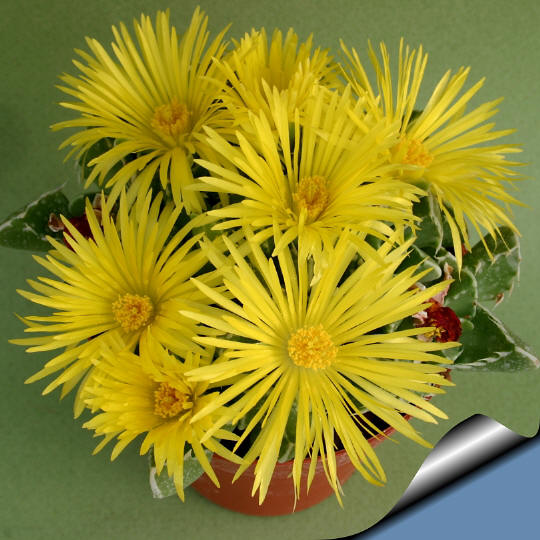
The yellow flowers are 4 cm across and very showy
Propagation: Faucaria tuberculosa is very easy to start from
seed. Seeds germinate in 7-14 days at 21°C. Although they will start
from cuttings, it is quite difficult to get them to root. If they start
to rot there is usually part of the plant that can be removed and
possibly rooted.
Photo of conspecific taxa, varieties, forms and
cultivars of Faucaria tuberculosa:
|
|